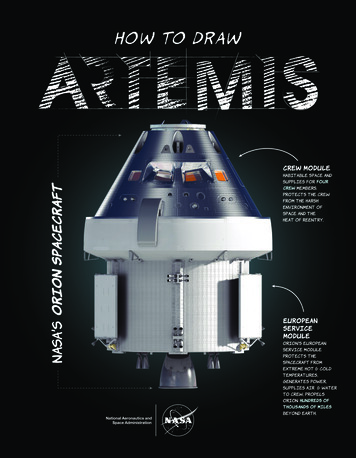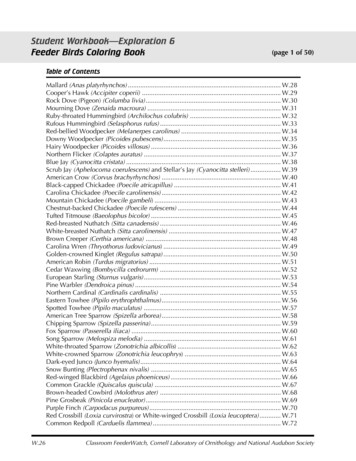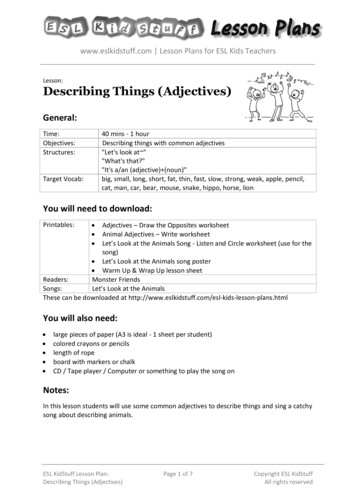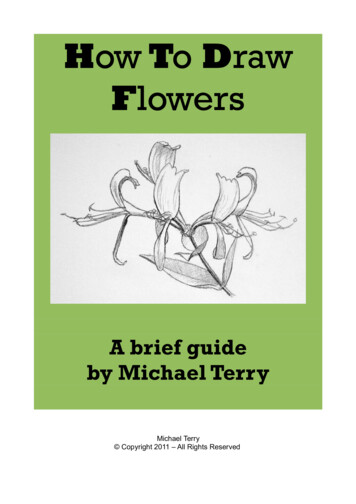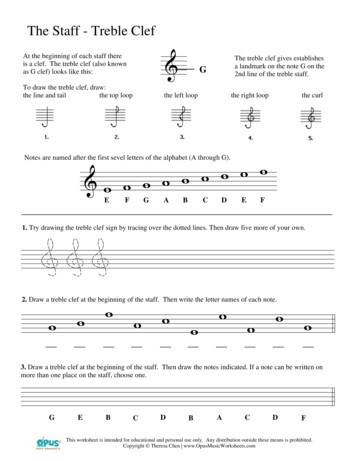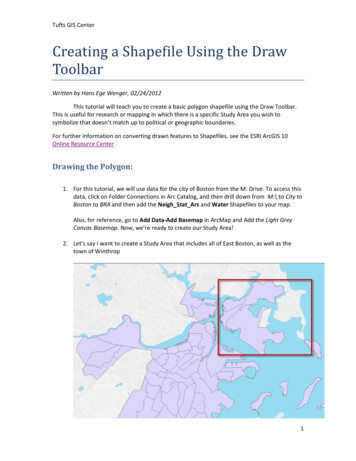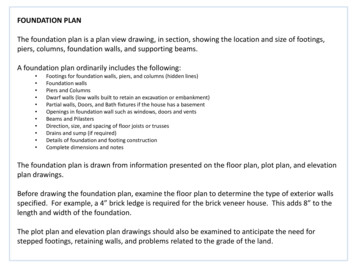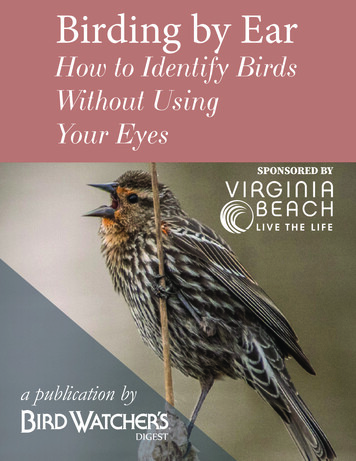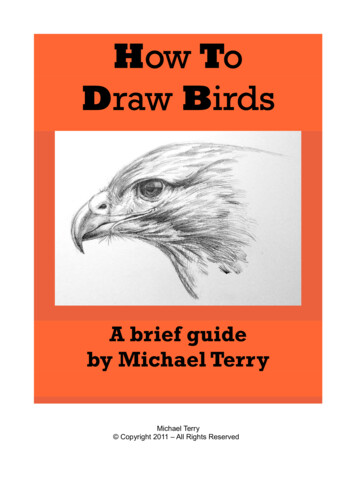
Transcription
How ToDraw BirdsA brief guideby Michael TerryMichael Terry Copyright 2011 – All Rights Reserved
Welcome to www.performingpencil.comthe site dedicated to drawing.How to draw birds.Birds are very rewarding to draw, there is such variety in shape andsize from the tiny wren to a magnificent golden eagle. Can you thinkof any other group of creatures that has such contrast, on the onehand you have the small plain and humble dunnock and on theother a strutting glorious peacock! There is so much to draw hereso much to observe and capture.For the most part being able to draw something is down to carefulobservation, take time to study what you wish to draw. Look at it'sproportions, how big is one part to another, find a part of it that youcan compare to the rest . Also look for how things relate, visualize ahorizontal line running from lets say the beak that you are drawingacross to the back of the head, does it line up like this on the birdyou are drawing? Or a vertical line running up from where you aredrawing in the legs to the back, do they need to be moved either tothe left or right or are they just fine?But before you start first chose a soft drawing pencil like a 4B or8B and get a soft putty eraser rather than a conventional eraserand a good quality drawing pad, these will help in achieving theresults you are after.For drawing birds sit at your window and do quick sketches of birdson your bird table, this is a good way to get to know different birdspostures and behaviour. Or go to a park with a lake or pond anddraw the water fowl and pigeons who can be obliging.What I am going to show you now is how to start and work throughto a finished drawing.
So lets get started.Start by getting the overall shape of the body, head and tail, thehead being the smallest can be used as a measure for the rest.Here I would like to mention a very useful tool for gettingproportions right, its called the 'Proportion Measure' and isincluded within the full eBook.To continue make sure you sketch lightly as you will want to removeany unwanted lines later.Next sketch in the wings then the beak and legs/feet, once you aresatisfied that all these are in proportion you can start defining thebird's shape.Next you can start on the detail but before you do so you can eraseany unwanted lines, other wise it will be difficult once all the detailsare in place.Now you can render in some shading, this will give it a more threedimensional appearance.
Now I want to show you the differentstages of producing a drawing.First here is an overview of the process.
This first example is of a robin.Stage OneThe first stage is to get the overall body shape, once you are happywith this then you can move to the next.
Stage TwoI have now added the basic shape of the tail.
Stage ThreeNow I have added the head and the wing, the with of the head isthe same as the length of the tail.Measuring one shape against another will help you get shapes theright size.
Stage FourHere I have added the beak, feather areas on the wing and abranch.
Stage FiveI have added the eye, legs and more detail to the drawing, this isthe refining stage.
Stage SixThis is my final stage, I have lightly rubbed out the pencil lines sothat I can put in the detail like the feathers on the wing.I have also added shading to give the bird form.
The second example is an egret toreinforce the principles.Stage OneHere like the first example I have drawn the basic body shape.
Stage TwoNow I have added the head, neck and lower body shapes. Here youcan now use the head as a measure, in this instance the length ofthe head goes one and a half times into the length of the top bodyshape.
Stage ThreeNext I have added shape to the head.
Stage FourLegs have now been added and some ripples to indicate the waterit's standing in.
Stage FiveHere I have now began to add shape to the basic shapes, the eyeand head feathers have also been added.Very close to finishing the drawing.
Stage SixHere is the final drawing, I have added more detail like the feathersnear the tail and detail on the body also shading to help show form.One thing to remember, this is just a sketch not a finished piece thatis going into the Royal Academy Summer Exhibition! Just relax itdoesn't mater if you make mistakes, just learn from them and enjoyyour self!Don't forget just relax and enjoy drawing, its a big adventure with agreat ending.
Further Help.I hope you have enjoyed this eBook sample and have found ithelpful in developing your drawing skills, if so then why not get holdof the complete book which is full of helpful advise on drawing.What I have given you in this sample is only a basic guide, there isa lot more in the full eBook which will help you to produce a drawingyou will be happy with. Below are the subjects covered within thebook.As I said at the beginning I have also included an invaluable toolthat will go a long way in helping you to achieve the results you arelooking for in your drawings. I have called this tool the 'ProportionMeasure' and I think you will find this indispensable.The eBook 'How to Draw Birds' has a great deal more within it tohelp you to develop your drawing skills.The subjects covered are:Familiarizing yourself with the subject.How much to draw.How to hold and use a pencil or pastel.Measuring proportions.Drawing through the subject.Negative space.Shading to show form and depth.Perspective.Step by step guide on how to draw a Buzzards headHere I will go through the stages of a drawing which will further helpyou to understand the process.Lastly I cover the subject of how to render feathers.And also the invaluable 'Proportion Measure' tool.Go to www.performingpencil.com to obtain this or one of theother eBooks available.
Below are some more photos for you to draw from.Black tailed GodwitBlue Tit
Coot
WidmonthsIf you want to go even further in your development there arecourses available at Wildmonths.com These provide projects foryou to work on and also if you wish personal feedback and helpwith your work.There is also a forum and gallery to show your work on.So go and have a look at Wildmonths.com, apart from the coursesavailable there is a wealth of information on wildlife together withmy wildlife diary which include many of my photos taken in the field.A deeper understanding of wildlife can only help in your drawing.www.wildmonths.comHelping your understanding of the natural worldLinnet
For drawing birds sit at your window and do quick sketches of birds on your bird table, this is a good way to get to know different birds postures and behaviour. Or go to a park with a lake or pond

